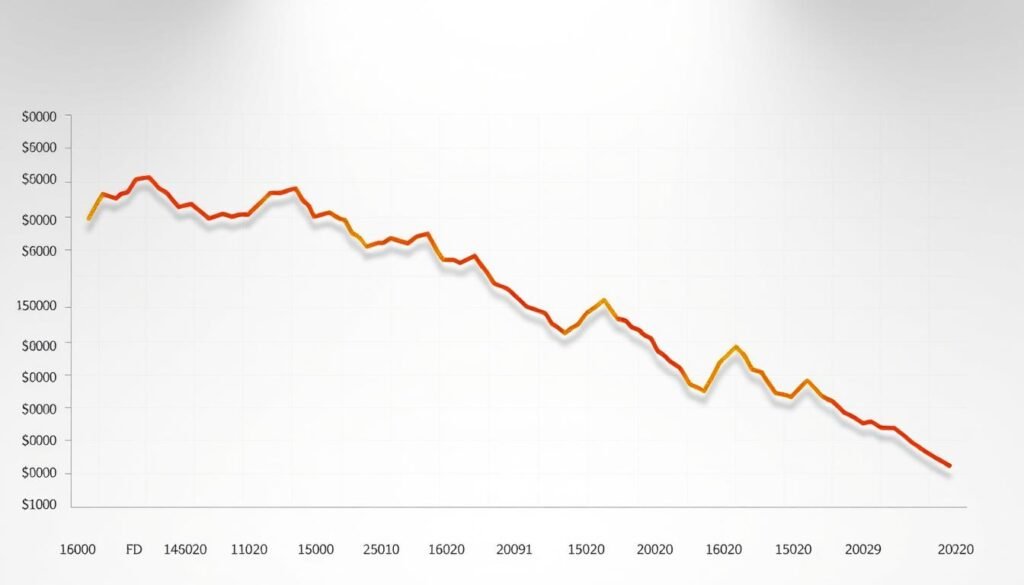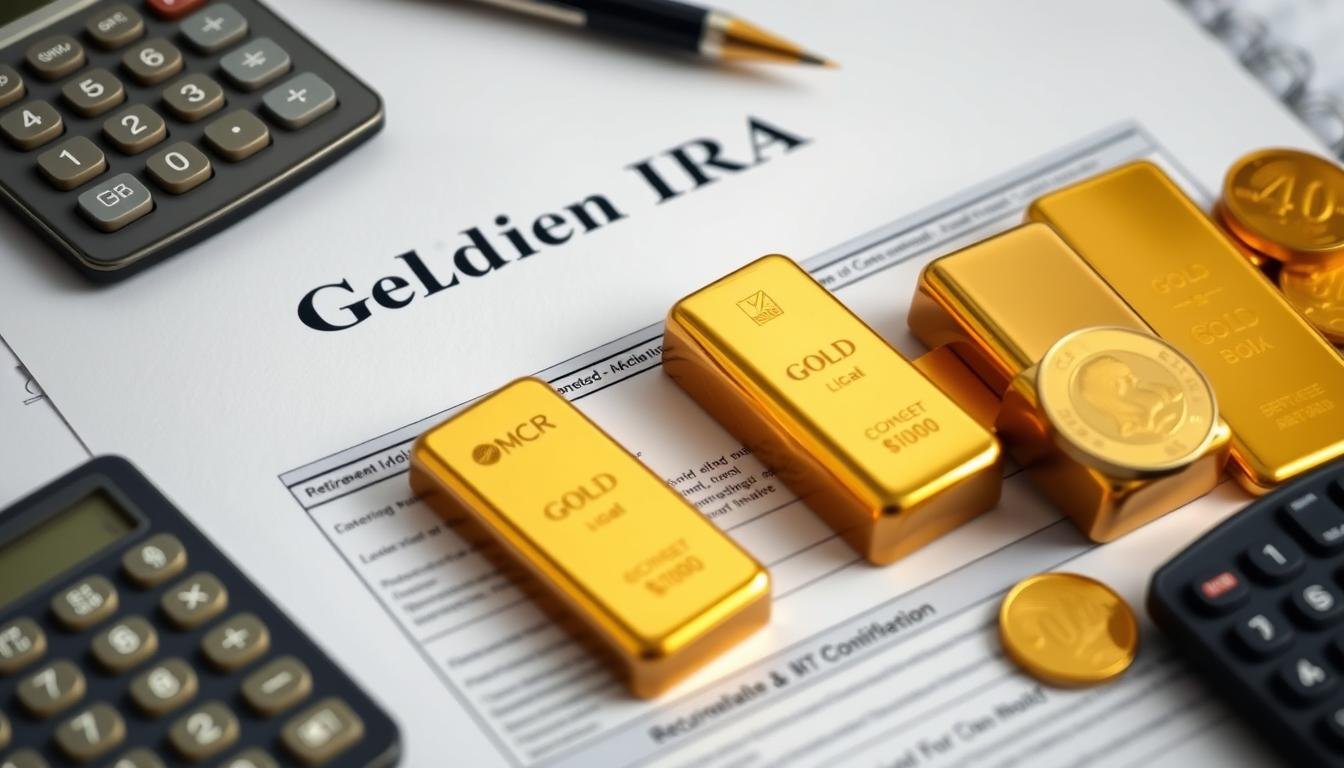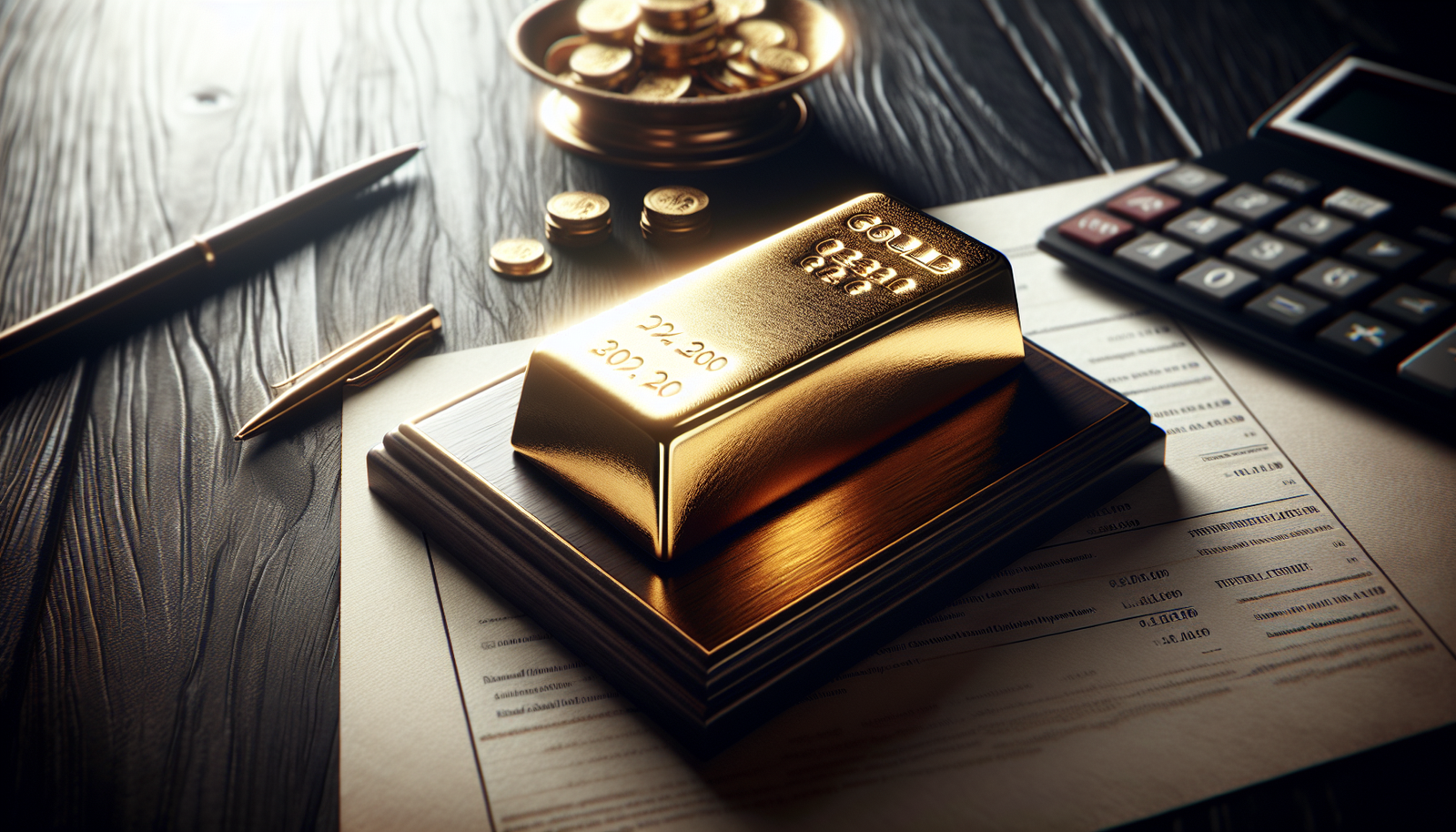For retirees concerned about economic uncertainty, a Gold IRA offers a tangible way to protect retirement savings from market volatility, inflation, and currency devaluation. Unlike traditional retirement accounts that rely solely on paper assets, a Gold IRA allows you to hold physical precious metals within a tax-advantaged structure, providing a sense of security during turbulent times. This comprehensive guide explores how Gold IRAs work, the specific fears they address, and the steps to establish your own precious metals retirement account.
What Is a Gold IRA and How Does It Differ from Traditional Retirement Accounts?
Physical gold in a Gold IRA provides tangible asset security unlike traditional paper-based retirement accounts
A Gold IRA (Individual Retirement Account) is a self-directed retirement account that allows investors to hold physical precious metals like gold, silver, platinum, and palladium instead of traditional paper assets like stocks and bonds. This specialized IRA follows the same tax rules as conventional retirement accounts but provides the unique benefit of holding tangible assets.
Key Differences Between Gold IRAs and Traditional Retirement Accounts
| Feature | Gold IRA | Traditional IRA |
| Asset Types | Physical precious metals (gold, silver, platinum, palladium) | Stocks, bonds, mutual funds, ETFs |
| Storage Requirements | IRS-approved depository required | Digital holdings managed by custodian |
| Inflation Protection | Strong historical hedge against inflation | Variable depending on investment selection |
| Market Correlation | Often moves inversely to stock market | Typically follows market trends |
| Tangibility | Physical assets you can see and touch | Paper assets represented by statements |
Like traditional IRAs, Gold IRAs come in several varieties: Traditional Gold IRAs (tax-deductible contributions with taxable withdrawals in retirement), Roth Gold IRAs (after-tax contributions with tax-free qualified withdrawals), and SEP Gold IRAs (for self-employed individuals and small business owners).
The primary appeal of a Gold IRA is that it combines the tax advantages of a retirement account with the security of physical precious metals, creating a powerful tool for portfolio diversification and wealth preservation.
Common Fears Threatening Retirement Security

Many retirees worry about economic factors that could erode their retirement savings
Today’s retirees face unprecedented economic challenges that threaten the security of their retirement savings. Understanding these concerns is the first step toward addressing them with appropriate investment strategies.
Inflation: The Silent Retirement Killer
Inflation represents one of the most significant threats to retirement security. Even modest inflation rates of 2-3% annually can dramatically reduce purchasing power over a 20-30 year retirement period. The U.S. inflation rate reached 9.1% in June 2022, the highest level in over 40 years, highlighting how quickly this threat can intensify.
“Many retirees underestimate inflation’s impact. At just 3% inflation, your purchasing power is cut in half after 24 years—well within the timeframe of most retirements.”
Market Volatility and Sequence of Returns Risk
Market crashes and corrections pose a serious threat to retirement portfolios, especially for those who have recently retired or are about to retire. The sequence of returns risk—experiencing poor market performance in the early years of retirement—can devastate a portfolio even if long-term averages appear adequate.
Recent history has demonstrated this volatility: the 2008 financial crisis saw the S&P 500 drop by 38.5%, and the COVID-19 pandemic triggered a 34% market decline in just 33 days during 2020. For retirees withdrawing funds during these downturns, the impact can be devastating and permanent.
Currency Devaluation and Banking System Concerns
Government monetary policies, including unprecedented levels of quantitative easing and growing national debt (exceeding $34 trillion in 2023), have raised concerns about the long-term stability of the U.S. dollar. Many retirees worry that their dollar-denominated savings could lose significant value if confidence in the currency erodes.
Additionally, banking system failures, like those seen in 2023 with Silicon Valley Bank and Signature Bank, have renewed concerns about the safety of financial institutions where retirement funds are often held.
Protect Your Retirement from These Threats
Discover how a Gold IRA can help shield your retirement savings from inflation, market volatility, and currency devaluation. Our free guide explains everything you need to know.
How Physical Gold in an IRA Addresses Retirement Concerns

Gold has earned its reputation as a “safe haven” asset through centuries of maintaining value during economic turmoil. When incorporated into a retirement strategy through a Gold IRA, it offers specific protections against the concerns that keep many retirees awake at night.
Gold as an Inflation Hedge
Historical data supports gold’s role as an inflation hedge. During the high inflation period of 1973-1979, when inflation averaged 8.8% annually, gold delivered average annual returns of 35%. More recently, as inflation surged in 2021-2022, gold prices increased by over 15% while many traditional investments struggled.
Unlike paper currency, which can be printed in unlimited quantities, gold’s supply grows at only about 1.5% annually. This scarcity helps gold maintain purchasing power over time, making it an effective counterbalance to inflationary pressures.
Gold’s Performance During Market Downturns
| Economic Crisis | S&P 500 Performance | Gold Performance |
| 2008 Financial Crisis (Oct 2007-Mar 2009) | -56.8% | +25.5% |
| Dot-com Bubble (2000-2002) | -49.1% | +12.4% |
| Black Monday (1987) | -33.5% | +5.8% |
| COVID-19 Crash (Feb-Mar 2020) | -34.0% | +3.6% |
Gold’s tendency to move independently—and often inversely—to stock markets makes it valuable for portfolio diversification. During the 2008 financial crisis, while the S&P 500 lost over 56% of its value, gold gained more than 25%. This pattern has repeated throughout history, demonstrating gold’s ability to provide stability when traditional investments falter.
Protection Against Currency Devaluation
As a global asset valued in all currencies, gold provides insulation against the devaluation of any single currency, including the U.S. dollar. When the dollar weakens, gold typically strengthens, helping preserve purchasing power for retirees.
From 2000 to 2020, as the U.S. dollar lost approximately 40% of its purchasing power, gold increased in value by over 500%, demonstrating its effectiveness as a hedge against currency devaluation.
“Gold has maintained its value throughout 5,000 years of recorded history. It has outlasted countless currencies, governments, and economic systems. That’s why it continues to play an important role in a well-diversified retirement portfolio.”
Speak with a Gold IRA Specialist
Learn how to properly allocate precious metals in your retirement portfolio based on your specific situation and concerns.
Gold IRAs vs. Other “Safe Haven” Retirement Options

While gold offers unique benefits for retirement security, it’s important to understand how it compares to other assets commonly considered “safe havens” for retirement savings.
- Strong historical inflation hedge
- Physical asset not dependent on any issuer’s promise
- Typically moves inversely to stock market
- Cannot be printed or created like currency
- 5,000+ year history as a store of value
- No counterparty risk
- Tax-advantaged in IRA structure
Gold IRA
- Backed by “full faith and credit” of U.S. government
- Provide regular interest income
- Generally less volatile than stocks
- TIPS offer some inflation protection
- Highly liquid market
- Subject to interest rate risk
- Returns may not keep pace with inflation
Treasury Bonds
- Tangible asset with utility value
- Can generate rental income
- Potential tax advantages
- Historical appreciation over time
- Less liquid than financial assets
- Requires active management
- Subject to local market conditions
Real Estate
The Optimal Approach: Strategic Diversification
Financial experts generally recommend diversification across multiple asset classes rather than concentrating retirement savings in any single vehicle. A balanced approach might include traditional retirement accounts, a Gold IRA, real estate investments, and fixed-income securities.
“The ideal retirement portfolio includes a strategic allocation to gold and precious metals—typically 5-15% depending on your risk tolerance and time horizon. This provides insurance against systemic risks while allowing participation in traditional growth assets.”
By incorporating a Gold IRA alongside other retirement vehicles, you create a more resilient portfolio capable of weathering various economic scenarios, from inflation and market crashes to currency devaluation and geopolitical instability.
Step-by-Step Guide to Setting Up Your Gold IRA

Establishing a Gold IRA involves several specific steps to ensure compliance with IRS regulations while maximizing the benefits of precious metals ownership in a tax-advantaged structure.
-
Choose a Reputable Gold IRA Company
Select a company with strong credentials (A+ BBB rating, positive customer reviews), transparent fee structures, and educational resources. Top-rated companies include Augusta Precious Metals, Goldco, and Birch Gold Group.
-
Select a Self-Directed IRA Custodian
Your Gold IRA must be administered by an IRS-approved custodian specializing in precious metals. Leading custodians include Equity Trust Company, STRATA Trust Company, and Kingdom Trust.
-
Fund Your Gold IRA
You can fund your account through a direct transfer from an existing IRA, a rollover from a 401(k) or other qualified retirement plan, or a cash contribution (subject to annual IRA contribution limits).
-
Select IRS-Approved Precious Metals
The IRS has specific requirements for precious metals held in IRAs. Gold must be 99.5% pure (except for American Gold Eagles), silver must be 99.9% pure, and platinum and palladium must be 99.95% pure.
-
Arrange Secure Storage
IRS regulations require that precious metals in an IRA be stored in an approved depository. Home storage is not permitted. Reputable depositories include Delaware Depository, Brink’s Global Services, and IDS of Texas.
IRS-Approved Precious Metals for Gold IRAs
| Metal | Approved Products | Purity Requirement |
| Gold | American Gold Eagle, Canadian Gold Maple Leaf, Australian Gold Kangaroo, Austrian Gold Philharmonic, Gold bars and rounds from approved refiners | 99.5% (except American Gold Eagles) |
| Silver | American Silver Eagle, Canadian Silver Maple Leaf, Australian Silver Kookaburra, Mexican Silver Libertad, Silver bars and rounds from approved refiners | 99.9% |
| Platinum | American Platinum Eagle, Canadian Platinum Maple Leaf, Australian Platinum Koala, Platinum bars and rounds from approved refiners | 99.95% |
| Palladium | Canadian Palladium Maple Leaf, Palladium bars and rounds from approved refiners | 99.95% |
Understanding Gold IRA Fees
Gold IRAs typically involve several types of fees that should be considered when evaluating providers:
- Setup fee: One-time charge for establishing your account ($50-$150)
- Annual administration fee: For account maintenance and IRS reporting ($75-$300 annually)
- Storage fee: For secure depository storage ($100-$300 annually)
- Transaction fees: For buying or selling precious metals (varies by provider)
- Seller’s premium: Markup over the spot price of metals (typically 3-5% for gold)
Many Gold IRA companies offer promotions that waive certain fees for qualifying accounts, such as fee waivers for the first year or reduced storage fees for larger accounts.
Important: The IRS prohibits “home storage” Gold IRAs. Despite some misleading advertisements, all precious metals in a Gold IRA must be stored in an IRS-approved depository to maintain tax-advantaged status.
Expert Insights on Portfolio Diversification with Gold

Financial experts widely recognize the importance of diversification in retirement planning, with precious metals playing a strategic role in creating resilient portfolios.
“The traditional 60/40 portfolio of stocks and bonds is increasingly vulnerable in today’s economic environment. Adding a Gold IRA component of 5-15% provides a counterbalance to paper assets and helps protect against systemic risks that could affect both stocks and bonds simultaneously.”
“Gold serves as portfolio insurance. You hope you never need it, but you’ll be grateful to have it during times of severe market stress or currency devaluation. For retirees who can’t afford to rebuild their nest egg after a major downturn, this insurance aspect is particularly valuable.”
“I recommend clients consider their age when determining gold allocation. Those closer to or in retirement might benefit from a larger allocation—perhaps 10-20%—while younger investors with longer time horizons might start with 5-10%. The key is having some exposure to this non-correlated asset class.”
The Psychology of Retirement Security
Beyond the financial benefits, many retirees report significant psychological advantages from owning physical gold in a retirement account. The tangible nature of precious metals provides peace of mind that purely digital assets cannot match, especially for those who have witnessed financial system failures or currency devaluations during their lifetime.
A 2022 Gallup survey found that 26% of Americans consider gold the best long-term investment—higher than real estate among those aged 65 and older. This perception often translates into greater confidence and reduced anxiety about retirement security.
Get Expert Guidance on Gold IRA Investing
Speak with a specialist who can help you determine the right precious metals allocation for your unique retirement situation.
Frequently Asked Questions About Gold IRAs
Is a Gold IRA safe?
Yes, Gold IRAs are considered safe investments when established with reputable companies and custodians. The physical precious metals are stored in IRS-approved depositories with full insurance coverage against theft or damage. These facilities maintain the highest security standards, including 24/7 monitoring, armed guards, and regular audits.
From a financial perspective, gold has maintained value for thousands of years and typically performs well during economic uncertainty. However, like all investments, gold prices can fluctuate in the short term. Gold IRAs are best viewed as a long-term wealth preservation strategy rather than a short-term investment vehicle.
Can I transfer my existing 401(k) to a Gold IRA?
Yes, you can transfer funds from an existing 401(k) to a Gold IRA through a process called a rollover. This is possible if you’re no longer employed by the company sponsoring the 401(k) or if your plan allows for in-service distributions. The process typically involves these steps:
- Open a self-directed Gold IRA account with a qualified custodian
- Request a direct rollover from your 401(k) administrator to your new Gold IRA custodian
- Once funds are received, direct your Gold IRA custodian to purchase approved precious metals
A direct rollover (custodian-to-custodian) avoids tax withholding and potential penalties. Most reputable Gold IRA companies will guide you through this process to ensure compliance with IRS regulations.
Check if Your Retirement Account Qualifies
Find out if your existing retirement account is eligible for a tax-free rollover to a Gold IRA.
How much of my retirement portfolio should be in gold?
Financial advisors typically recommend allocating between 5% and 15% of a retirement portfolio to precious metals, including gold. However, the ideal percentage depends on several factors:
- Your age and time horizon until retirement
- Your overall risk tolerance
- Your concerns about specific economic risks (inflation, market crashes, etc.)
- Your existing portfolio composition
Those closer to or in retirement often benefit from a slightly higher allocation (10-15%) for greater stability, while younger investors might start with a smaller position (5-10%). It’s advisable to consult with a financial advisor to determine the appropriate allocation for your specific situation.
What are the tax implications of a Gold IRA?
Gold IRAs follow the same tax rules as traditional or Roth IRAs, depending on which type you choose:
- Traditional Gold IRA: Contributions may be tax-deductible, and growth is tax-deferred. Withdrawals in retirement are taxed as ordinary income.
- Roth Gold IRA: Contributions are made with after-tax dollars, but qualified withdrawals in retirement are completely tax-free, including any appreciation in the value of your precious metals.
Required Minimum Distributions (RMDs) apply to Traditional Gold IRAs beginning at age 72, but not to Roth Gold IRAs. Early withdrawals before age 59½ typically incur a 10% penalty plus applicable taxes, with certain exceptions.
Can I take physical possession of the gold in my Gold IRA?
While your Gold IRA holds physical precious metals, IRS regulations require that these assets be stored in an approved depository until you take a distribution. Taking physical possession of gold within your IRA would be considered a distribution, subject to taxes and potential penalties if you’re under age 59½.
However, when you reach retirement age and decide to take distributions, you can choose to:
- Take physical possession of the metals (taxable event for Traditional IRAs)
- Sell the metals and take the cash value
- Continue holding the metals in the depository
Many retirees appreciate the option to eventually take physical possession of their gold, providing additional flexibility compared to traditional paper-based retirement accounts.
Securing Your Retirement with a Gold IRA
A Gold IRA offers worried retirees a powerful tool for preserving wealth and achieving peace of mind in uncertain economic times. By combining the tax advantages of a retirement account with the historical stability of physical precious metals, you create a more resilient financial foundation for your golden years.
The unique properties of gold—its ability to hedge against inflation, its tendency to perform well during market downturns, and its 5,000-year history as a store of value—make it a strategic complement to traditional retirement assets. For retirees concerned about economic instability, currency devaluation, or market volatility, a properly structured Gold IRA can provide both financial protection and psychological reassurance.
As with any investment decision, proper education and guidance are essential. Consider consulting with a financial advisor experienced in precious metals to determine the right allocation for your specific situation and goals.
Take the First Step Toward Retirement Security
Download our comprehensive guide to learn everything you need to know about protecting your retirement with a Gold IRA.














